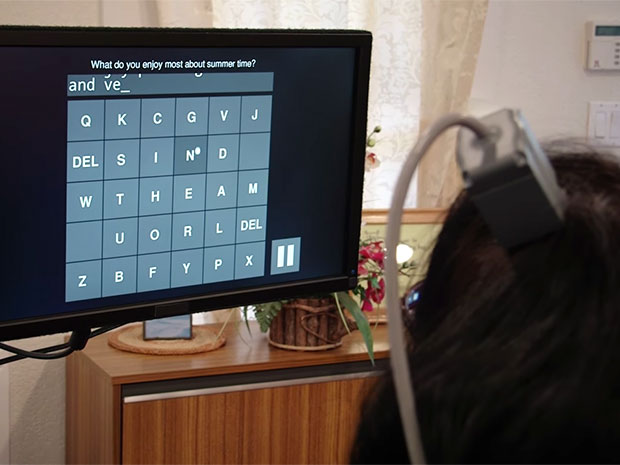New record: paralyzed gaining eight words per minute using a brain implant

Source: Stanford University
There are many paralyzed people in the world. In the US alone, 5.1 million people are paralyzed to one degree or another. In some cases, paralysis is progressive. Amyotrophic lateral sclerosis is one of the diseases that leads to complete paralysis. Over time, a person suffering from this disease, loses the ability to manage even the facial nerves, and in the final stage of the disease - and the muscles of the eyeballs.
Such patients cannot communicate with other people or respond to external factors. They are self-contained, although mental activity is usually not affected. Previously, the opportunity to communicate with such people was absent, they were left to themselves. But with the development of technology, new opportunities appear in medicine. For example, the development of Niels Birbaumer, an employee of the Wyss Center for Bio and Neuroengineering, helped to understand what people think who have no motor activity.
Doctors led by Birbaomer created a neural interface that measures in real time the level of oxygen in the blood and the electrical activity of the brain. When creating their systems, scientists set a goal to learn to understand when a paralyzed person says (mentally) “yes” and when “no”. Such a system, unfortunately, is suitable only for dialogue in the "question-answer" mode, and the answers, as we see, are monosyllabic.
')
Colleagues Birmbauer from Stanford have developed technology that allows such patients to communicate using printed text . The letters of paralyzed people are typed on the virtual keyboard, which is located on the screen in front of them. True, the technology requires invasive intervention - the implantation of the smallest electrodes into the human brain. There are about a hundred such electrodes in the system, and they are so thin that physicians can implant them next to the neurons of the brain regions responsible for controlling the movement of the hands.
A special system perceives signals from these neurons, processes it using an algorithm, and transmits it via cable to a computer with an input device. For typing, a person with an electrode needs to imagine how he moves his hand by pressing the virtual button with the letter shown on the screen.
Before using the system, the patient needs training, but most volunteers manage the virtual keyboard almost immediately. After training, the project participants are asked to print the phrase “The quick brown fox jumped over the lazy dog”, which contains all the letters of the English alphabet and spaces. Now scientists from Stanford, led by Krishna Shena and Jamie Hnedreson, are working with three volunteers. All of them are paralyzed, although they have the ability to control the muscles of the eyes, facial muscles, or even completely retain the ability to control facial expressions and even speak.
One patient named Dennis Dagrey lost the opportunity to move in 2007. He went to throw garbage, although it was raining outside. Without carrying the bags of waste to the dumpster just a few meters, he slipped on the grass and fell. When he fell, Daegray hit his chin badly, causing damage to his spinal cord. Daegray cannot control any muscle located below the point where the skull connects to the spine. He can speak, but cannot type or control the computer.
New technology helped Dennis and two more volunteers to communicate again using a computer. The speed of typing in this case was 7.8, 6.3, and 2.7 words per minute for each of the patients. Dennis is the leader of the troika, his indicator is almost 8 words per minute.
For comparison, the speed of typing on a smartphone screen by an ordinary person who is familiar with modern technology is 12-30 words per minute. The gap from the bottom of Dennis is not that big. He himself perceives the new system as a video game, which gives great pleasure and for which you do not need to pay.
A woman who also participates in the experiment once helped developers find a bug in the system. That day she tried to communicate, as usual, but did not work - the cursor did not move to the right. She also retained the ability to speak, so she was able to report the problem to the developers. After three days of searching for the bug, they still found it and realized that the patient was right.
So far, the system that scientists at Stanford have created is a trial one. It is based on the results of the study of the same team, conducted in 2015. Then the specialists managed to create an algorithm that processes the signal of the monkey's brain (later - a human) and a pointing cursor on the screen in the direction where the implanted electrode owner wanted to move it.
This is just a prototype that developers will improve. In 10 years, according to the project participants, the systems will be much more perfect: auto-calibrated, wireless and miniature. There will be no glands protruding from the head. People can work with such a system both with partial paralysis and patients who are completely unable to move.
Source: https://habr.com/ru/post/401803/
All Articles